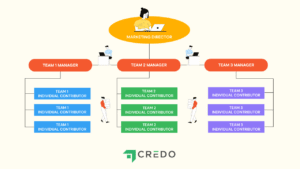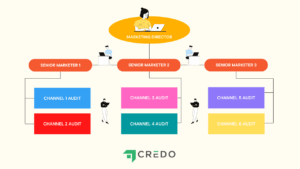If you’ve determined it’s time to hire an outside marketing agency, you need to build a team to support your initiatives, oversee marketing channels, and manage your agency partners.
Even if you are not currently ready to hire an outside provider, the likelihood that you will want—or need—to hire one in the future is high. Looking ahead, you should consider what your most efficient marketing team organization and structure would look like.
If you’re a marketing leader, business owner, or key decision-maker, then your success—as mentioned—hinges on your ability to hire, retain, and motivate a team that produces results.
As a leader, you require a bird’s eye view of your entire brand in order to manage the bucket of roles previously discussed. That’s the most salient reason that you can’t straddle the line between manager and individual contributor for long. At least not without losing track of the top-level view that allows you to manage deadlines, staff, client relations, and more.
What is the best thing you can do as a leader? Hire yourself out of a job and do it on a constant basis. John is absolutely adamant about doing this and does it himself. That keeps him freed up to manage the bigger picture of Credo.
Your mission is to find top talent, hire them, and then let them own the areas where they excel. If you micromanage those you hire for their expertise, you’ll likely end up with a lot of unhappy staff and a high turnover rate on your team. Then, it’s back to the hiring board.
As a manager, your job is to remove any impediments that prevent them from doing their job. Your job is not to be in the trenches as a contributor and a manager at the same time.
There are three ways that the brands we work with structure their marketing teams:
Our clients include large companies ($50M+ a year in revenue) that have had success hiring agencies on a short-term basis to handle strategy. Generally, this is done while they are in the process of hiring a new marketing executive.
From there, your new executive can scale out the marketing team and manage agency relationships—if an agency is still required at this point. This structure has a lot of moving parts but it is a viable stopgap while you look to fill important roles.
Here are visuals of the three marketing structures explained above.
Director of Marketing, Channel Managers & Individual Contributors

This is the most common team setup. Within this structure, there are senior marketers who manage teams of junior team members. The junior staff is channel-specific or sometimes channel ownership overlaps—depending on the team, their skill sets, and workload.
You can see the potential problem if no one is clear on who owns which channel.
This scenario works well when teams have specific areas of ownership, whether a product or channels. These teams will still often hire agencies for specific needs and to fill in gaps where expertise or general knowledge on a specific strategy is lacking.
Director of Marketing, Channel Owners & Agency Partners

Here, the business is committed to working with agencies that specialize in each channel. Each channel has a clear owner who then manages the specialized agency. Sometimes one agency can work across channels and help with integrated marketing campaigns, and other times channel-specific agencies or strategists are required.
Which you need depends on your team composition and your most pressing needs.
Director of Marketing, Senior Marketers & Audits by Agencies

In this structure, the three senior marketers are all tasked with different channels. Each determines the strategy and viability of the channel they own. They work with an agency to define the opportunity and strategy—and then determine if they should hire someone to own that channel. Or, if the agency is the best, most cost-effective approach.
The first rule of structuring your team is that there is no one-size-fits-all structure.
The ideal structure for your marketing team depends on several factors, including:
That last bullet deserves repeating. Don’t forget about your experience hiring, managing, and optimizing a marketing team. Your own personality, experience, and skill set will determine the team you hire and the outside partners you need to engage—if any are required.
Most larger companies (over $50 million a year in revenue) we work with build out the first structure listed above. They’re well-established, have their acquisition channels identified, and generally have a sustainable business model. In this case, agencies that they find through Credo help accelerate channels—rather than get new ones up and running.
Medium-sized companies ($10M-$50M a year in revenue) that we work with generally build out the second structure listed above. These teams have a fairly clear idea of what works but need to move faster than hiring a full in-house team. For most companies of this size, this leaner structure works well.
The downside of this second approach is that you need channel owners who are also adept at project management—and who are willing and able to fill that role. Basically, you need manager-level channel owners who can maintain profitable agency relationships.
For the most part, scaling companies ($1M-$10M a year in revenue) fall into the third structure. If you are in this stage, you probably have a person or two on your team in addition to yourself. You are likely still the main marketer for some channels.
At this stage, you have to be choosy about the channels in which you are investing and working with an outside partner. Your team’s time is limited and your skill sets may be varied yet still limited, so you have to find the right partner that supplements what you already have.
This page last updated on February 23, 2024 by John Doherty
Oops! We could not locate your form.
Drive results for your marketing needs with the Credo network. Get started today (it's free and there is no obligation)!